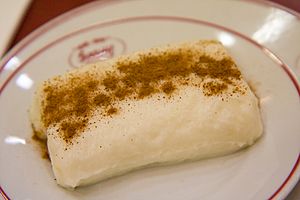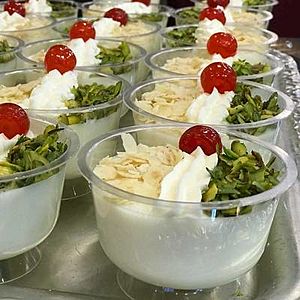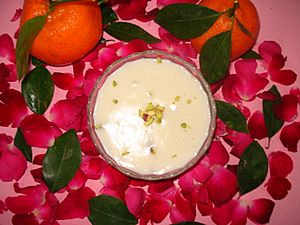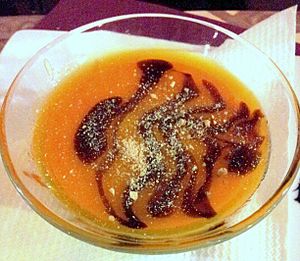Muhallebi facts for kids
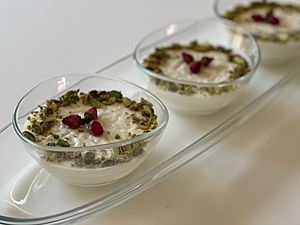
Muhallebi decorated with pistachios and rose petals
|
|
| Course | Pudding |
|---|---|
| Place of origin | Sassanid Persia |
| Serving temperature | Cold |
| Main ingredients | Rice flour, milk or almond milk, sugar |
Muhallebi is a yummy milk pudding. It is usually made with rice, sugar, and milk. Sometimes, rice flour, starch, or semolina is used to make it thick. This dessert is very popular in the Middle East. People in Greece, Turkey, and Iraq call it Muhallebi. In Egypt, it is known as Mahalabia. In the Levant, it's called Mahalayeh.
Contents
A Sweet History
Stories say that muhallebi (Arabic: مهلبية) first came to Arab cuisine a long time ago. This was in the late 600s. A cook from Sassanid Persia made it for an Arab general. His name was Al-Muhallab ibn Abi Sufra. He loved the pudding so much that he named it after himself!
The oldest recipes for this pudding are from the 900s. They show three ways to make it. One used milk thickened with ground rice. Another had milk with rice grains and chicken. The third was an egg custard without rice. A cookbook from Baghdad by Ibn Sayyar al-Warraq has the earliest muhallabiyya recipe.
Later, in the 1200s, two Arab cookbooks shared a spicy version. This one used mutton instead of chicken. The idea that the pudding came from Persia is written in one of these cookbooks.
During the Middle Ages, muhallebi and a similar European dessert called blancmange both had shredded chicken. Records from the Ottoman Empire show two kinds of muhallebi. One had shredded chicken (tavuk göğsü). This was served when Mehmed the Conqueror was in charge. A later recipe from 1530 was meatless. It was flavored with rose water.
An English cookbook from the 1800s has a recipe for muhallebi. It calls the dessert "Ramazan cakes". The recipe says to boil milk with rice flour and sugar until it gets thick. Then, you add rose or jasmine flavor. After it cools, you sprinkle powdered sugar on top.
Muhallebi Around the World
Today, the old-fashioned tavuk göğsü with chicken is not common. You can mostly find it in Turkey. This pudding does not taste like chicken. But the shredded meat gives it a special texture. A person named George Coleman De Kay once said the pudding gets its great taste from young chicken breasts. They are mixed in so well you can barely tell they are there.
Kazandibi is another type of tavuk göğsü. For this one, a thin layer of the pudding is made crispy and brown. Then, the creamy part is poured over it. When it's ready, the pudding is served upside down. The crispy side is on top. In Istanbul, muhallebici shops also sell other treats. These include almond-based keşkül, Noah's Pudding, and baked rice pudding called fırın sütlaç.
In Syria, there is a محلاية ("Mahalayeh") called بالوظة ("Balouza"). This is the classic milk pudding. But it has a layer of orange jelly on top. You can also use other jelly flavors, like rose syrup. When you buy Mahalayeh in Syrian restaurants, it always has three stripes of toppings. These are sliced almonds, cream, and chopped pistachios. It also has a Maraschino Cherry on top. The famous Booza shop, Bakdash, in Damascus sells Mahalayeh and Booza.
In Israel, malabi (Hebrew: מלבי) is topped with chopped pistachios, dried coconut, and a red syrup. This syrup is usually made with rosewater or orange flower water. It gets its bright red color from food coloring.
In Cyprus, muhallebi is called μαχαλλεπί (IPA: [maxalːe'pi]). You can find it with milk or without milk. The Cypriot non-dairy muhallebi is made from water, sugar, and cornstarch. Sometimes, rose water is added. When the muhallebi is ready, Cypriots pour a rose syrup called triantafyllo (τριαντάφυλλο) on top.
Sometimes, a special flavor called mastic is used in muhallebi.
Special Occasions for Muhallebi
- Further information: Sephardic cuisine
In some Sephardic Jewish homes, malabi is a special dessert. It is made with milk, cream, starch, and sugar. It is flavored with rosewater or orange flower water. This dessert is eaten to break the fast on the Jewish holiday of Yom Kippur. It is also served at Turkish Jewish weddings. It symbolizes the sweet life the couple will have.
Sephardim also eat it on the festival of Shavuot. On this holiday, people usually eat dairy foods. Food historian Gil Marks says another reason is that this holiday is known as the "feast of roses" in this community. And the dessert has a lovely rose smell.
Muhallebi in Other Desserts
Muhallebi is also used to make other traditional desserts.
Selanik tatlısı is a dessert from Salonica. It is made by thickening a basic stovetop muhallebi with eggs. Then, it is baked with a sweet shortcrust pastry. Before serving, the dessert is soaked in a simple syrup. Another dessert from Salonica is muhallebi baklava. This is similar to the Greek galaktoboureko.


